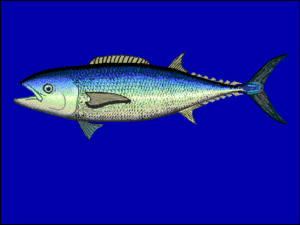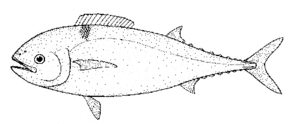Butterfly kingfish facts for kids
Quick facts for kids Butterfly kingfish |
|
|---|---|
 |
|
| Conservation status | |
| Scientific classification | |
| Synonyms | |
|
The butterfly kingfish (Gasterochisma melampus) is a fascinating ray-finned fish that lives in the ocean. It belongs to the Scombridae family, which also includes well-known fish like tunas and mackerels. However, this fish is very special! It's the only species in its own unique group, called the subfamily Gasterochismatinae and the genus Gasterochisma. This makes it stand out from all its relatives.
Even though "butterfly kingfish" is its official name, people have called it many other things. Some common names include big-scaled mackerel, butterfly tuna, and scaly tuna. In 1993, the U.S. Food and Drug Administration even said it could simply be sold as "mackerel."
Contents
What Does a Butterfly Kingfish Look Like?
Unique Fins and Scales
Young butterfly kingfish have huge pelvic fins. These fins are even longer than their heads! As the fish grows, these fins become more normal in size. No matter the size, these fins can tuck neatly into a special groove on their belly. This is similar to how other fish in the mackerel family hide their first dorsal fins.
This fish also has very large, round cycloid scales. Underneath these scales is a thick layer of fat. The butterfly kingfish has a swim bladder with two parts that reach into the back of its skull, near its inner ear. Unlike some other fish, it doesn't have a middle keel (a ridge) on its tail base. Instead, it has two small keels on each side, just like other fish in the mackerel family. It has 21 bones before its tail and 23 bones in its tail.
Where Do They Live?
You can find butterfly kingfish in southern parts of the world's oceans. They prefer cool waters, usually between 8 and 15 degrees Celsius (46-59 degrees Fahrenheit). They are most often found in water colder than 10 degrees Celsius (50 degrees Fahrenheit). These fish live in the open ocean, sometimes as deep as 200 meters (656 feet). They can grow to be quite large, reaching up to 1.64 meters (about 5.4 feet) long!
Warm-Blooded Fish?
Most bony fish are ectothermic, which means they are cold-blooded. Their body temperature changes with the water around them. But the butterfly kingfish is special! Like its relatives, the tunas, it is endothermic. This means it can keep its body temperature warmer than the surrounding water. It even has a special "brain heater" organ. This organ helps keep its brain warm and comes from one of its eye muscles.
Why is the Butterfly Kingfish So Unique?
Its Special Place in the Fish Family Tree
The butterfly kingfish has a very old and different evolutionary history compared to other fish in the Scombridae family. Its body shape is also quite different. Some scientists even thought it might belong to a completely different family!
However, studies of its body and its DNA show that the butterfly kingfish is like a "sister" group to all other fish in the mackerel family. This means it branched off very early in their evolutionary history. Because of this, its genus (Gasterochisma) and its subfamily (Gasterochismatinae) are both unique groups that contain only this one species.
The diagram below shows how the butterfly kingfish fits into the Scombridae family, separate from the tunas, mackerels, and bonitos.
| Butterfly kingfish, in the family Scombridae | |||||||||||||||||||||||||||||||||||||||||||||||||||||||||||||||||||||||||||||||||||||||||||||
|
|||||||||||||||||||||||||||||||||||||||||||||||||||||||||||||||||||||||||||||||||||||||||||||
| Cladogram: With 51 different species in the Scombridae, the butterfly kingfish sits apart from the rest – it is the only scombrid species that does not belong to the subfamily Scombrinae. |



